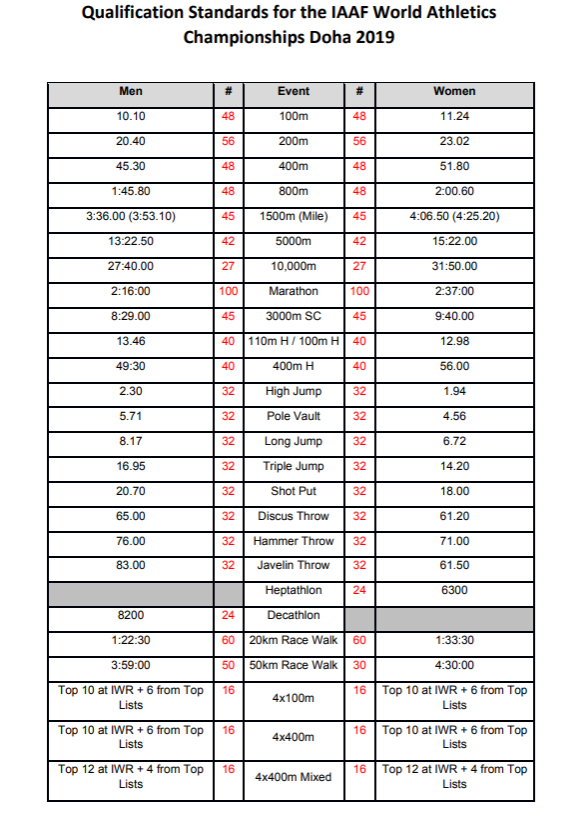IAAF Announces Tougher 2019 World Championships Entry Standards — Which Ones Were Changed The Most?
By LetsRun.com
December 4, 2018
We’re still 297 days away from the start of the 2019 World Championships in Qatar, which will be held between September 27 and October 6, 2019, but we now know what times the athletes will be shooting for. Today, the IAAF announced the official entry standards for the meet.
Initially, the IAAF was planning on using a world ranking system to determine who qualified for Worlds, but after feedback from athletes, coaches, and agents, decided to shelve that system for the time being. That means the main way to qualify is the same as it was in 2017 — hit the IAAF standard.
There are several other ways to qualify. Once again, all defending champions will be given a bye into the championships, as will all 2019 Diamond League champions. Note that this is a change — in past years, the previous year‘s Diamond League champion would earn a bye to Worlds. But because the 2019 Diamond League season wraps up before the 2019 Worlds begins, the IAAF has decided to give the byes to the 2019 DL champs.
The reigning area champions (NACAC, Euros) will also be considered to have achieved the entry standard (note that this is not the same as earning a bye), though there are some exceptions to that rule (see here for all the details). The top 15 finishers at the 2019 World Cross Country Championships will also be considered to have achieved the entry standard in the 10,000 meters.
Once again, if there are not enough auto qualifiers in an event, the IAAF will fill the fields to reach a target number of entries (shown in red in the table below).
The qualifying window runs from March 7, 2018, to September 6, 2019, for the 10,000m, marathon, race walks, relays, and combined events. For all other events, the window goes from September 7, 2018, to September 6, 2019.
You can view the full details on the qualifying procedure for the 2019 World Championships here.
So how do those standards compare to those from the 2017 Worlds and 2016 Olympics? We compared the marks from all three championships below:
Men
Red text denotes the standard is harder than in 2017.
| 2019 Worlds | 2017 Worlds | 2016 Olympics | |
| 100 | 10.10 | 10.12 | 10.16 |
| 200 | 20.40 | 20.44 | 20.50 |
| 400 | 45.30 | 45.50 | 45.40 |
| 800 | 1:45.80 | 1:45.90 | 1:46.00 |
| 1500 | 3:36.00 (3:53.10 mile) | 3:36.00 (3:53.40 mile) | 3:36.20 |
| 5k | 13:22.50 | 13:22.60 | 13:25.00 |
| 10k | 27:40.00 | 27:45.00 | 28:00.00 |
| Marathon | 2:16:00 | 2:19:00 | 2:19:00 |
| 3k steeple | 8:29.00 | 8:32.00 | 8:30.00 |
| 110 hurdles | 13.46 | 13.48 | 13.47 |
| 400 hurdles | 49.30 | 49.35 | 49.40 |
| HJ | 2.30m | 2.30m | 2.29m |
| PV | 5.71m | 5.70m | 5.70m |
| LJ | 8.17m | 8.15m | 8.15m |
| TJ | 16.95m | 16.80m | 16.85m |
| SP | 20.70m | 20.50m | 20.50m |
| Discus | 65.00m | 65.00m | 65.00m |
| Hammer | 76.00m | 76.00m | 77.00m |
| Javelin | 83.00m | 83.00m | 83.00m |
| Decathlon | 8200 pts | 8100 pts | 8100 pts |
| 20k race walk | 1:22:30 | 1:24:00 | 1:24:00 |
| 50k race walk | 3:59:00 | 4:06:00 | 4:06:00 |
Women
Red text denotes the standard is harder than in 2017.
Green text denotes the standard is easier than 2017.
| 2019 Worlds | 2017 Worlds | 2016 Olympics | |
| 100 | 11.24 | 11.26 | 11.32 |
| 200 | 23.02 | 23.10 | 23.20 |
| 400 | 51.80 | 52.10 | 52.20 |
| 800 | 2:00.60 | 2:01.00 | 2:01.50 |
| 1500 | 4:06.50 (4:25.20 mile) | 4:07.50 (4:26.70 mile) | 4:07.00 |
| 5k | 15:22.00 | 15:22.00 | 15:24.00 |
| 10k | 31:50.00 | 32:15.00 | 32:15.00 |
| Marathon | 2:37:00 | 2:45:00 | 2:45:00 |
| 3k steeple | 9:40.00 | 9:42.00 | 9:45.00 |
| 100 hurdles | 12.98 | 12.98 | 13.00 |
| 400 hurdles | 56.00 | 56.10 | 56.20 |
| HJ | 1.94m | 1.94m | 1.93m |
| PV | 4.56m | 4.55m | 4.50m |
| LJ | 6.72m | 6.75m | 6.70m |
| TJ | 14.20m | 14.10m | 14.15m |
| SP | 18.00m | 17.75m | 17.75m |
| Discus | 61.20m | 61.20m | 61.00m |
| Hammer | 71.00m | 71.00m | 71.00m |
| Javelin | 61.50m | 61.40m | 62.00m |
| Heptathlon | 6300 pts | 6200 pts | 6200 pts |
| 20k race walk | 1:33:30 | 1:36:00 | 1:36:00 |
| 50k race walk | 4:30:00 | 4:30:00 | N/A |
A few comments:
- It is harder to qualify in almost every event in 2019 than it was in 2017, particularly the women’s 10,000 (31:50 vs. 32:15) and the marathons (2:16:00 vs. 2:19:00, 2:37:00 vs. 2:45:00). The only event in which it is easier to qualify is the women’s long jump (6.72m vs. 6.75m).
- The entry standard in the women’s 1500 went down by a full second while the men’s standard remained unchanged. In the U.S., only two men ran 3:36.00 or faster outdoors in 2018, while 16 women ran 4:07.50 or faster (the 2017 standard) and 11 women ran 4:06.50 or faster (the 2019 standard). Globally, 69 women ran 4:07.50 or faster outdoors in 2018 (53 ran 4:06.50 or faster) compared to just 39 men running 3:36.00 or faster.
- American athletes who don’t have the IAAF standard by USAs will have six weeks to chase the standard. USAs is July 25-28; the deadline to achieve the standard is September 6.


